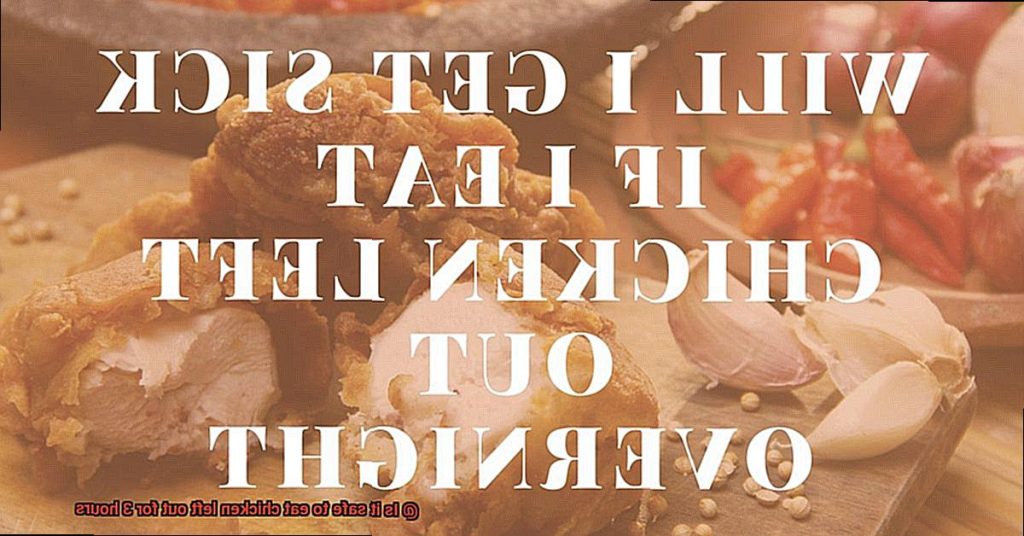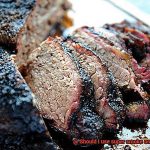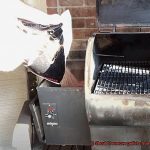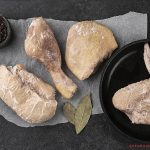Imagine this: You’ve been cooking your famous chicken dish all day for a dinner party with friends. Everyone arrives, and the meal is a hit. But as the night wears on, you forget to put away the leftover chicken. The next morning, you’re left wondering if it’s safe to eat chicken that’s been sitting out for three hours.
It’s a common situation that many of us have found ourselves in at one time or another. We all know how important it is to keep our food at the right temperature to avoid getting sick, but sometimes life gets in the way. So, can you still safely consume chicken that’s been left out for three hours?
In this blog post, we’ll delve into the science behind food safety and explore the potential risks of consuming improperly stored chicken. We’ll also give you tips on best practices to ensure your food stays fresh and safe to eat. Whether you’re a seasoned cook or just love trying new recipes, this post is for you. Get ready to learn everything you need to know about eating chicken left out for 3 hours.
Contents
The USDA Guidelines for Food Safety
The USDA guidelines for food safety play an essential role in ensuring that the food supply in the United States is safe for consumption. As an expert, I cannot stress enough the importance of following these guidelines, particularly when it comes to handling, storing, and cooking chicken.
Chicken is a notorious carrier of harmful bacteria like Salmonella and Campylobacter. Therefore, it’s crucial to exercise extra care when dealing with this protein source. The USDA recommends several guidelines to help prevent the growth of bacteria that could cause foodborne illnesses.
Firstly, it’s crucial to note that raw chicken should never be left out at room temperature for more than two hours. This is because temperatures between 40°F and 140°F (known as the danger zone) provide a favorable environment for bacteria to multiply rapidly. If chicken is left out for more than two hours in this danger zone, it may not be safe to eat.
Furthermore, if the temperature outside is above 90°F, then perishable foods like chicken should not be left out for more than one hour. The warmer temperature can cause bacteria to grow even faster, increasing the risk of foodborne illness.
When cooking chicken, the USDA recommends a minimum internal temperature of 165°F to kill any harmful bacteria present. To ensure that chicken is cooked to perfection, it’s essential to use a food thermometer to measure its internal temperature accurately.
Additionally, when storing cooked chicken, it’s essential not to leave it out at room temperature for more than two hours. If you’re not planning on eating the chicken within two hours, refrigerate or freeze it promptly to prevent bacterial growth.
Factors That Affect the Time Limit for Leaving Chicken Out
That’s why it’s important to understand the factors that affect the time limit for leaving chicken out.
First up is temperature. If you store your chicken in a room that’s warmer than 90 degrees Fahrenheit, don’t leave it out for more than an hour. If the temperature is between 40 and 90 degrees Fahrenheit, it’s safe to leave it out for up to two hours. Keep an eye on the thermometer and store your chicken accordingly.
Next, cooked versus raw. Raw chicken should never be left out at room temperature for more than two hours. However, if the chicken has been cooked, you can leave it out for up to four hours at a temperature of 140 degrees Fahrenheit or higher. After four hours, though, it’s time to discard any leftovers.
The type of chicken also plays a role. Boneless chicken breasts may dry out and become unsafe to eat more quickly than other cuts of chicken because they have less fat and moisture. Keep this in mind when deciding how long to leave them out.
Lastly, consider the conditions under which the chicken was prepared and stored before being left out. If it was left out on a dirty or contaminated surface, it may have already been exposed to harmful bacteria before being left at room temperature.
Different Types of Chicken Require Different Handling Instructions
When it comes to handling chicken, not all types are created equal. Different types of chicken require different handling instructions to ensure food safety. Raw chicken, for instance, needs to be handled with extra care, as it can carry harmful bacteria that can cause foodborne illness. Salmonella and Campylobacter are two common types of bacteria found in raw chicken. Therefore, raw chicken should never be left out at room temperature for more than two hours.
When it comes to cooked chicken, the rules change slightly. Cooked chicken can be left out for up to two hours before it becomes unsafe to eat. However, this time frame can vary depending on the temperature and humidity of the environment. If the temperature is above 90°F, cooked chicken should not be left out for more than one hour.
Different cuts of chicken have different levels of fat content and connective tissue. These factors can affect how quickly they spoil if left out at room temperature. For example, boneless, skinless chicken breasts are leaner and tend to spoil faster than bone-in chicken thighs. This is because they have less fat content and more surface area exposed to the air, which can lead to faster spoilage.
The way the chicken is prepared can also impact its safety when left out. For example, if the chicken is breaded or marinated, it may spoil more quickly because of the added moisture. Breaded or marinated chicken should never be left out at room temperature for more than two hours.
Proper storage is also crucial in preventing contamination and ensuring food safety when handling chicken. Raw chicken should always be stored separately from other foods and cooked in a clean and sanitized area. Cutting boards, utensils, and dishes used for raw chicken should also be washed with hot soapy water before using them again.
How to Properly Cook and Store Chicken
Properly cooking and storing chicken is essential to avoid foodborne illness. Bacteria like salmonella and campylobacter can cause serious health risks if chicken is not cooked to the appropriate temperature or stored properly. Here are five sub-sections that will guide you on how to cook and store chicken safely.
Cooking Chicken to the Right Temperature
Cooking chicken to 165°F (74°C) ensures that harmful bacteria are destroyed. Use a meat thermometer to check the temperature of the thickest part of the chicken, and make sure there is no pink or red meat visible. Also, wash your hands and all utensils, cutting boards, and surfaces that will come into contact with the chicken to prevent cross-contamination.
Storing Cooked or Raw Chicken
Bacteria grow rapidly between 40°F (4°C) and 140°F (60°C), so it’s essential to keep chicken at a safe temperature. Cooked or raw chicken should be refrigerated at 40°F (4°C) or below within two hours of cooking. Leftovers should be stored in an airtight container and consumed within three to four days. If freezing chicken, it should be packaged in an airtight container or freezer bag and labeled with the date it was frozen. Frozen chicken can be stored for up to six months in the freezer.
Buying Pre-Cooked Chicken
If you’re buying pre-cooked chicken from a store, be sure to follow the storage instructions on the package. Most pre-cooked chicken should be refrigerated and consumed within a few days.
Marinating Raw Chicken
Marinating chicken adds flavor but can also increase the risk of foodborne illness if not done correctly. Always marinate raw chicken in the refrigerator, not at room temperature, and make sure it’s cooked thoroughly before consuming.
Throwing Out Chicken That’s Not Safe to Eat
If you’re not sure whether your chicken is safe to eat, it’s better to throw it out than risk getting sick. Look for signs of spoilage like bad odor or slimy texture. Always remember to practice good food safety habits like washing your hands and cooking chicken thoroughly.
What to Do If You’re Not Sure Whether Your Chicken Is Safe To Eat
Chicken is a popular protein that can be found in many dishes, but it’s important to ensure that it’s safe to eat. If you’re not sure whether your chicken is safe to consume, there are some steps you can take to avoid the risk of foodborne illness. Here are five sub-sections explaining what to do:
Use Your Senses
The first step is to use your senses when assessing the chicken. Check for any signs of spoilage such as a sour or rotten smell, slimy texture, or discoloration of the meat. If it looks or smells off, it’s best to discard it immediately. It’s always better to be safe than sorry.
Check the Temperature
Proper temperature control is crucial for preventing bacterial growth that could cause food poisoning. If the chicken has been left out in the “danger zone” between 40°F and 140°F for more than two hours, it’s no longer considered safe to eat. Use a food thermometer to check the internal temperature of the chicken. It should be at least 165°F before consuming.
Be Cautious
When in doubt, throw it out. If you’re still unsure about the safety of the chicken, it’s better to discard it rather than risk getting sick from contaminated food.
Follow Guidelines
Different types of chicken have different guidelines for safe handling. Raw chicken should never be left out at room temperature for more than two hours, while cooked chicken should not be left out for more than two hours at room temperature. Make sure to follow these guidelines closely and never take shortcuts when it comes to food safety.
Practice Good Food Safety Habits
To prevent contamination and ensure that your food is safe to eat, always wash your hands before and after handling raw chicken, cook chicken thoroughly, and follow storage instructions on packages. Additionally, make sure to clean and sanitize any surfaces or utensils that come into contact with raw chicken.
Tips for Practicing Good Food Safety Habits
Practicing good food safety habits is crucial when handling chicken, as it can easily become contaminated with harmful bacteria. Here are five sub-sections that explain the importance of following proper food safety habits:
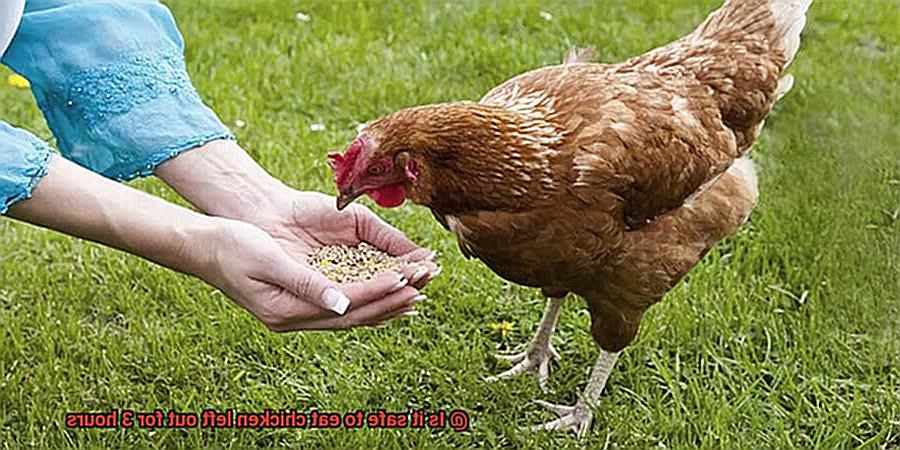
Proper Storage
Storing chicken at the right temperature is essential to prevent the growth of bacteria. Refrigerate raw chicken at or below 40°F and freeze it at 0°F. When thawing frozen chicken, do so in the refrigerator, microwave, or cold water. Never leave chicken at room temperature as it can lead to bacterial growth.
Cleanliness
Washing hands, utensils, and surfaces before and after handling raw chicken is important to prevent cross-contamination. Hot, soapy water should be used to clean utensils and surfaces to kill bacteria.
Cook Chicken Thoroughly
Cooking chicken to an internal temperature of 165°F ensures that all harmful bacteria are killed. Use a meat thermometer to check the temperature, and make sure not to rely on the color of the meat or juices as an indicator of doneness.
Avoid Cross-Contamination
Cross-contamination can occur when raw chicken comes into contact with other foods or surfaces. Using separate cutting boards and utensils for raw chicken helps prevent this from occurring.
Don’t Leave Chicken Out for Too Long
Perishable items like chicken should not be left out at room temperature for more than two hours. If the temperature is above 90°F, perishable items should not be left out for more than one hour. Marinating raw chicken should also be done in the refrigerator rather than at room temperature.
The Dangers of Eating Undercooked or Improperly Stored Chicken
Firstly, chicken can carry harmful bacteria such as Salmonella and Campylobacter that can cause serious health consequences. When you don’t cook chicken to the proper internal temperature of 165°F, these bacteria can survive and cause foodborne illnesses. You could experience symptoms such as diarrhea, nausea, vomiting, fever, and in severe cases, hospitalization may be required.
Proper storage of chicken is also essential in preventing the growth of harmful bacteria. Chicken should be kept at a temperature below 40°F in the refrigerator and below 0°F in the freezer. Leaving chicken out at room temperature for more than two hours puts it at risk of developing harmful bacteria, especially if exposed to moisture or warmer temperatures.
To summarize, here are some key points to remember when handling and cooking chicken:
- Cook chicken to an internal temperature of 165°F
- Store chicken properly at a temperature below 40°F in the refrigerator and below 0°F in the freezer
- Don’t leave chicken out at room temperature for more than two hours
- Avoid cross-contamination by using separate cutting boards and utensils for raw chicken
y8V7kmj3T9o” >
Conclusion
To sum up, consuming chicken that has been left out for three hours is not advisable. According to the USDA’s food safety guidelines, raw chicken should never be left at room temperature for more than two hours. This is because bacteria thrive in temperatures between 40°F and 140°F, which can lead to foodborne illnesses. Moreover, if the weather outside is above 90°F, perishable foods like chicken should not be left out for more than one hour.
It’s essential to take into account various factors that influence the time limit for leaving chicken out, such as temperature, cooked versus raw, type of chicken, and how it was prepared and stored before being left out. Different types of chicken require different handling instructions to ensure food safety.
Proper cooking and storage of chicken are crucial to avoid foodborne illness. Bacteria such as Salmonella and Campylobacter can pose severe health risks if chicken is not cooked at the appropriate temperature or stored correctly. To prevent contamination and ensure safe consumption of your food, always practice good food safety habits such as proper storage, hygiene practices, avoiding cross-contamination, cooking chicken thoroughly, and refraining from leaving it out at room temperature for too long.
Remember that when you’re unsure about the safety of your chicken, it’s better to discard it rather than risk getting sick from contaminated food.

